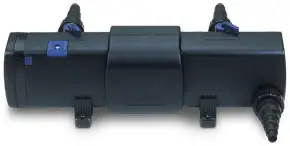Guide to Pond UV Filters
When ultraviolet radiation is discussed, the subject is usually skin cancer and other maladies caused by the intense levels of this radiation found in sunlight. UV pond filtration, however, is one of the best resources available in the fight against pollutants such as algae. The reason this radiation is so powerful an ally in this fight is actually exactly the same as it is a potential danger where sunlight is concerned. Before one begins to worry, be aware that the levels of ultraviolet radiation emitted by pond filter bulbs is really nothing compared to what one's skin receives from sunlight. The radiation produced by these pond UV filters is really only dangerous to algae.
The Basics

Ultraviolet radiation destroys living organisms by irreparably damaging the DNA in the cell's nucleus. Simply put, when algae contained in the pond water is exposed to the UV light, it is damaged to the point where the cell cannot divide and reproduce. This genetic damage slowly eliminates harmful algae from the water.
These UV filters are among the slower-working types but they do produce excellent results given enough time. Be prepared to keep manually pulling algae mats out of the water for a while before seeing the results of one's UV filter in the fullest. When those results are realized, they will be significant.
How they Work
A UV pond light is actually very simple. There is a bulb which emits light in the ultraviolet, as well as the visible, spectrums. There is attached to this bulb a quartz sleeve that protects the bulb from the water and a ballast and housing in which the electrical components of the light are contained. There will generally be a spot on the ballast and housing where the light is visible. This is simply to ensure that the bulb is burning. Do not look directly into the light. Even though it is very low power, it's bad for one's eyes to gaze directly into it.
Water is pulled through the pond UV light by the action of the pump. The filter will only be rated to handle a certain amount of gallons per hour (GPH). Exceeding this limit will essentially render the UV light useless. Be certain that the filter one purchases is adequate for one's pond.
There is a bit of inherent confusion where the term "filter" is applied to pond UV accessories. In the proper sense of the word, these are not filters. They do not nor should they be expected to replace a basket filter. They simply kill the algae that comes through them but they remove nothing from the water. One still needs a proper filter to perform this task.
That being said, a UV filter will only clarify water if the water is made cloudy by algae. Any other impurities will be unaffected. However, if one's pond is turbid with algae, a difference will be noticed after one of these filters is kept in use for a time.
A pond UV will not attack filamentous algae. These are the types of pond algae that appear as long, green fans on fixtures such as waterfalls and fountains. These are self-contained colonies of algae and, as such, they won't be dragged under the light. Any algae set floating in the water when these nuisances are manually removed, however, will eventually be passed under the UV bulb and killed.
Making these devices work requires some attention to detail.
Placement
Where filtration is concerned, placement is everything. The filter will be fed by the pump's intake hose. This needs to be located as far as possible from the hose that returns the water to the pond. Having them next to one another causes a water current that essentially stirs the pollutants back into the water. Keep the intake away from features such as waterfalls and fountains, as well.
Maintenance
As a pond UV clarifier or pond UV sterilizer is used, the sleeve will tend to become caked with various types of gunk. This needs to be cleaned. If it is not kept clean, too little UV light will be allowed to penetrate the water and, thus, the algae will not be killed.
Other than that, UV lights are fairly maintenance-free devices. Always check to make sure the bulb is working, of course. Whether or not the bulb is burning, it will need to be replaced at regular intervals for the best results.
Purchasing
Pond UV filters are commonly marketed as clarifiers or sterilizers. The names do have some meaning. A clarifier of the same wattage as a sterilizer will not be as effective at eliminating algae from the water. There are many variables that make these devices work and the raw wattage is not always the best indicator of how effective the filter will prove.
Remember that a pond UV device is an enhancement to one's pond filtration, not a means to total filtration in and of itself. One still needs to have plants, a basket filter, a good pump and, preferably, a biological filter installed to achieve the best results. These devices are remarkably effective but they will not remove particulate matter from the water.
Be certain to purchase a unit that is up to the job one has in store. It's easy to inadvertently purchase a device that is too small. The algae that collects in fish ponds tends to be more significant than that which collects in water gardens. Keep this in mind and, as is the case with pumps and other types of filters, it's best to purchase a device that is a bit larger than one actually needs rather than to try to get by with something smaller.
A UV light is an excellent choice when one needs to keep an algae problem under control. Be prepared to wait for a while until the results are fully realized and make certain that the device is on at all times. Over time, the result will be wonderfully clear water!

